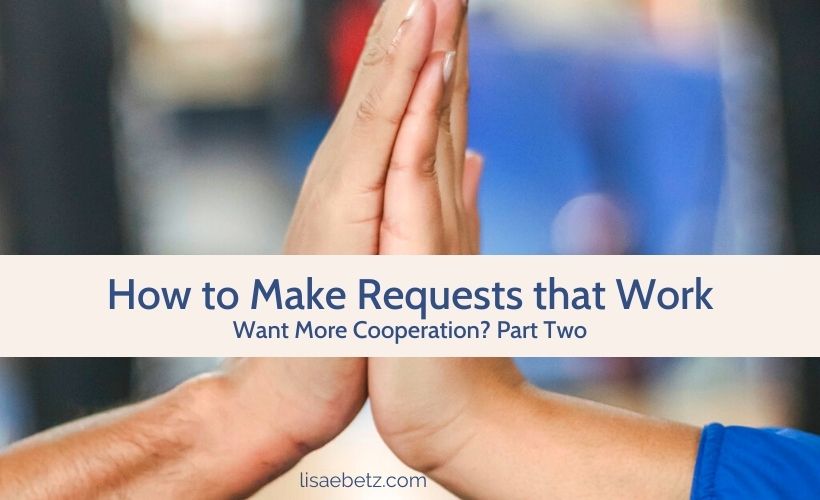While you and I may never be asked to broker peace in war-torn nations, we all face situations of conflict, from small complaints to hostile interactions. Last post I introduced a method for resolving conflicts through dialogue, based on the book Nonviolent Communication. This post covers the final step, learning how to make requests that work.
The goal is to request what we need, without blaming, criticizing, threatening, or demanding. When we make requests in this way, we are much more likely to inspire compassion instead of defensiveness, and thus be granted what we are asking for.
In other words, this process helps us go from conflict and counterattack to understanding and win-win outcomes.
First a brief recap of the nonviolent communication process.
The four-part process that leads to more cooperation
- Observations. Make neutral observations about the situation, avoiding language that conveys a judgement or assumption on your part. (“This is the third day in a row you’ve left your socks on the floor.” rather than “You are a slob.”)
- Feelings. Identify the emotions you feel due to the observation that has been stated. (When I see the dirty socks on the floor, I feel frustrated and annoyed.)
- Needs. Discern what unmet needs are causing the feelings. (“I need order to relax. That’s why I take the time to keep the house tidy after a busy day. I need to know that you notice my efforts and care that I work so hard to keep our home looking nice. I would appreciate it if you helped me.)
- Requests. Clearly and gently make requests regarding the needs you have identified. (Would you help me keep the house orderly by remembering to put your dirty socks in the hamper?”)
The first three steps are explained in this post. The final step in the process is learning how to make requests that work by expressing our unmet needs in a way that encourages cooperation instead of defensiveness.
Three tips to make requests that work
1. State requests with positive language
We respond better when given a positive action to accomplish rather than a prohibition. Therefore, we will have more success getting others to comply with our requests when we avoid using negatives. Consider the following requests:
- Please don’t leave your dirty socks on the floor.
- Please put your dirty socks in the hamper.
Notice how the second request gives a clearer explanation of what you would like to happen. Also, an ornery person could comply with the first request by leaving dirty socks on the table or the sofa instead, which isn’t what you want.
If you are in the habit of expressing requests by stating what you don’t want, the single change of stating requests with positive language might make a big improvement!
2. Don’t hint. Instead, state requests directly
Many of us have a habit of hinting for what we want instead of asking directly and clearly. Unfortunately, vague hints rarely get good results.
“For centuries, the image of the loving woman has been associated with sacrifice and the denial od one’s own needs to take care of others. … [therefore] women, if they ask for what they want, will often do so in a way that both reflects and reinforces the beliefs that they have no genuine right to the needs and that the needs are unimportant.”
Dr. Marshall B. Rosenberg in Nonviolent Communication
Hints are not helpful because they don’t clearly state the needs that are at the root of the conflict. Some examples of requests stated as hints and why they don’t work.
- It would be nice if I didn’t have to pick up everyone’s dirty socks. (The listener could agree with our statement without seeing a need to pick up socks.)
- You know how busy I’ve been at work lately. Don’t you think I deserve to take a break instead of cleaning up after everyone? (The listener may or may not agree with the opinion that the speaker ‘deserves’ a break, and in any case, the need is not clearly expressed.)
3. Understand the difference between a request and a demand
When people express their needs clearly and without demands or threats, they greatly increase the likelihood that others will listen, understand, and cooperate. Unfortunately, we often word our requests as demands—statements that imply some sort of threat, punishment, or blame if the request is not met. A demand has strings attached. A request does not.
It may feel like requesting instead of demanding makes us weak, because we have no way to control the outcome. However, demands cause the listener to become defensive because they feel forced or guilt-tripped into complying.
Requests, on the other hand, acknowledge the other party is free to free to comply, or choose not to. Because we allow them the agency to make their own choices, we are giving them their need to feel
Are you ready to make requests that work?
Do you relate to the communication mistakes I’ve covered in these two posts? I know I do.
How can you use this technique to reduce conflict and enjoy more cooperation in your relationships? I wish you success as you practice identifying your unmet needs and rewording them to make requests that work.
Resources for further reading
Nonviolent Communication: A Language of Life by Marshall B. Rosenberg PhD
The Center for Nonviolent Communication website. Find training and other resources.


This kind of reminds me of constructive criticism in a lot of ways, as that teaches you to do something similar to help people grow without making them defensive
I think it’s basically the same goals. If only more of us would remember to talk this way more often!
Using constructive criticism with an assertive attitude I think gets more things done than when you tell, state the obvious, or are acting negatively. Good post!
I agree it gets more done. How often do we shoot ourselves in the foot by presenting our requests in negative or judgmental attitudes?